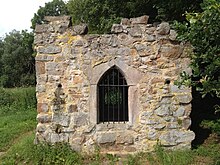Germanic garden at Windhausen Castle
The Germanic Garden of Windhausen Castle was an English landscape garden near Heiligenrode in the northern Hessian district of Kassel , which was laid out from 1781. It is the only romantic-sentimental Germanic garden in Germany .
Geographical location
The remains of the landscape garden are located 2.3 km east of Niestetal -Heiligenrode and 1.5 km south-south-west of the summit of the Mühlenberg ( 351.8 m above sea level ), a western branch of the Kaufunger Forest . They are located on the southern flank of the mountain near the Windhausen estate and castle at an altitude of around 260 to 300 m . To the west, past today's park, through whose eastern part the northeastern Losse tributary Diebachsgraben flows, leads the district road 5, which branches off from the K 4 (Heiligenrode– Nieste ) in the north and runs south to Niederkaufungen . The facility is located in the geo-nature park Frau-Holle-Land (Werratal.Meißner.Kaufunger forest)
history
Windhausen was the name of a village that no longer exists today, which was mentioned in 1241 as Windehusen , 1245 as Wenthusen and 1340 as Winthusen . The name is associated on the one hand with the altitude of the place and on the other hand with the alleged founder Winid . In 1342 the Lords of Windhausen were on the Mainz side in the armed conflict between Landgrave Heinrich II of Hesse and the Elector of Mainz and opened their castles to the Archbishop. Because of this, they lost their entire headquarters. In 1368 it finally became the property of the Landgrave, who in the same year pledged it to Duke Otto the Quaden of Braunschweig .
The estate then fell into disrepair until 1699, when Landgravine Amalia , wife of Landgrave Karl (1654–1730), and her son acquired Gut Windhausen.
General Martin Ernst von Schlieffen (1732–1825) had Windhausen Castle built from 1769 , probably by the architect Simon Louis du Ry (1726–1799), in a simple baroque style (approx. 1575–1770) . In addition, from 1781 he had the English landscape garden laid out to complement and round off the palace in terms of garden architecture.
The scientifically interested and reclusive General von Schlieffen spent his retirement in a reed-covered hermitage , and not in the manor house. He was buried in the mausoleum there , which he had built 51 years before his death in 1774.
A horde of monkeys was kept in a menagerie ( called the monkey house ) for the entertainment of General von Schlieffen . The monkeys were shot because of rabies . The general had the monkey monument erected in the form of a broken column (hence also called the monkey column ) in memory of the animals, probably between 1781 and 1788 . The inscription he wrote himself inspired Wilhelm Busch to write his well-known humoresque Fips, the monkey , published in 1879 during a stay in Windhausen Castle .
In 1840 the life story of Ernst Martin von Schlieffen appeared , on which he had worked at Gut Windhausen during his lifetime.
Today's park
In the romantic, sentimental landscape park there were a multitude of garden architecture buildings that artfully blended into the natural garden. These included a friendship stone , a monkey house , a monkey monument at the former monkeys Pond (also Small pond called), a Devil's Bridge (formerly 4 m high, 1,956 collapsed) with Rock Sea (also Steinernes Meer called), Schlieffen's Mausoleum and the Germanic elements Hertha sanctuary , Tomb of Arminius and Tuisco stone, which gave the garden its part of its name, Germanic Garden . The structures were connected by numerous naturally winding paths that included natural features and several ponds .
Today the landscape park is no longer preserved in its entirety, but only exists as a natural, overgrown park. The monkey monument , the tomb of Arminius , Schlieffen's mausoleum and the Gutsteich on the estate are particularly reminiscent of its existence . The park is used for forestry. The Niester Riesen premium trail, which has been 11.5 km long since May 2014 and was originally only 5.5 km long as a circular route, and the Sensenstein Castle hiking trail with the S. hiking trail lead past the 160 km long Kassel-Steig .
Individual evidence
- ↑ a b c d e f Gut Windhausen with information about the landscape garden, on the website of the Eco path Archeology Sensenstein , on eco-pfade.de
- ↑ EntdeckerTour Premiumweg P11 Niester Riesen , on naturparkfrauholle.land
literature
- Kerstin Möller: Manor and landscape park of the State Minister of Schlieffen on Gut Windhausen . Master's thesis University of Frankfurt am Main, 78 pp., 1992
- Eduard Brauns: Hiking and travel guide through North Hesse and Waldeck . Bernecker Verlag, Melsungen 1971, pp. 402-403
Coordinates: 51 ° 18 ′ 14.8 " N , 9 ° 36 ′ 51.5" E



